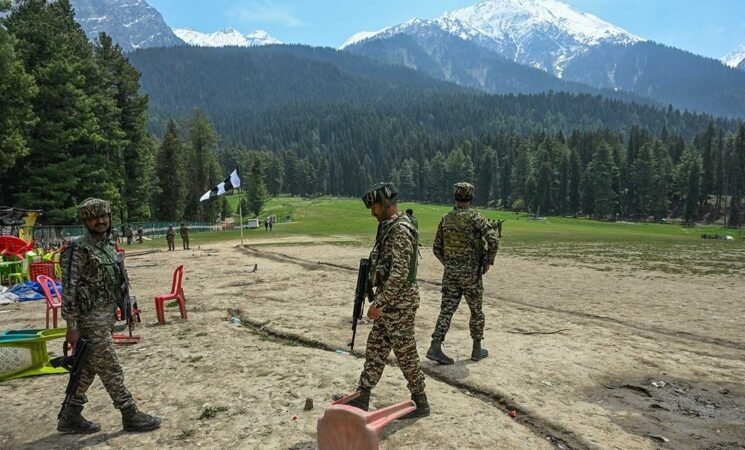11 May 2025, NIICE Commentary 10904
Jatin, Vimlok Tiwari, Akshat Pushpam
India and Pakistan are two nuclear-armed nations forged from a common history, and continue to live in a precarious state, where there is neither war nor peace. Their relationships are usually defined by hostility and punctuated by moments of violent confrontations. The recent Pahalgam incident has once again flared up, where Pakistan-sponsored terrorists have targeted Indian Nationals and shouted at 28 people after asking their religion. No doubt this event was tragic and provocative but it was not unfamiliar. Because it followed a pattern that has come to define bilateral tensions: the use of proxy actors by Pakistan and calibrated military responses by India. Yet, despite the growing intensity of these skirmishes, the dreaded descent into nuclear war has remained hypothetical.
Although there is a group of scholars who suggest otherwise and view incidents like Pahalgam or Pulwama as potential triggers of full-scale conflict, potentially spiraling into nuclear exchange. But they often ignore the lessons of history and the evolving strategic postures of both states. It is notable that India and Pakistan are adversaries but are not irrational actors. They understand that the threshold for nuclear engagement is high and crossing it would lead to catastrophic consequences. This is not a story of an imminent nuclear apocalypse but it is one of strategic restraint amid rising instability.
India and Pakistan have engaged in several rounds of military brinkmanship, from the Kargil conflict to the 2019 Balakot strikes and recent operation ‘Sindoor’, since acquiring nuclear weapons in 1998. But none of these escalations crossed into nuclear territory. Why? The answer lies in the nuanced concept of the stability–instability paradox. Nuclear weapons have increased strategic stability by preventing large-scale wars, but have also led to instability at lesser levels of warfare. Both states recognize with a tacit understanding that while proxy wars, drone surveillance, cyber intrusions, and limited retaliatory strikes may continue, any escalation beyond a certain point is off the table.
Such engagements which can be termed a sub-conventional or soft war, has become the new normal. In contrast to hard conventional wars involving total mobilization of forces (like the 1971 Indo-Pak war), sub-conventional conflicts involve calibrated, limited-force engagements. These may include cross-border raids, targeted air strikes, or maritime posturing, but they are carefully managed to avoid tipping into larger warfare.
Pakistan’s long standing doctrine of using asymmetric warfare, specially via non-state actors, to counterbalance India’s conventional superiority has institutionalized this grey-zone conflict. By sponsoring terrorist outfits and fuelling insurgency in Kashmir, Pakistan has attempted to keep India militarily engaged while avoiding direct confrontation. The term “bleeding India with a thousand cuts” is more than a rhetorical flourish as it reflects a conscious policy direction.
Meanwhile, India’s response has also evolved accordingly. The 2016 surgical strikes and the 2019 Balakot airstrikes were not knee-jerk reactions but were based on a doctrinal shift that allows India to impose costs on Pakistan without engaging in full-scale war. While these actions carry the risk of escalation, they also demonstrate India’s calibrated use of power to maintain deterrence without breaking the nuclear ceiling.
This emerging pattern resonates with the much-debated democratic peace theory, which suggests that democracies rarely, if ever, go to war with one another. Although India and Pakistan have had varying degrees of democratic maturity, the logic of political accountability and the economic costs of war act as significant constraints. What nuclear deterrence does at the strategic level, democratic governance does at the political level. These both concepts serve as buffers against unrestrained conflict.
Moreover, the international context cannot be ignored. Global powers, including the United States, China, and Russia, have a vested interest in preventing a nuclear flashpoint in South Asia. Diplomatic interventions, backchannel talks, and pressure from multilateral institutions have repeatedly helped de-escalate tensions at critical moments. The post-Pulwama diplomatic whirlwind is a case in point, where international mediation played a role in bringing both sides back from the brink.
Yet, peace in this region remains elusive. Kashmir continues to simmer, non-state actors continue to operate across porous borders, and domestic political pressures often dictate aggressive posturing. The likelihood of continued military and non-military confrontations between India and Pakistan remains high. However, the nuclear deterrent does not eliminate conflict but ensures that it remains within manageable bounds. It imposes a ceiling, not a resolution.
The real danger lies not in deliberate war but in miscalculation. With emerging technologies like drones, hypersonic weapons, and cyber capabilities entering the battlefield, the fog of war has thickened. A misinterpreted radar blip, an accidental incursion, or an unintended strike could potentially snowball into something far graver. It is within this narrow space between strategy and accident that the risk of escalation persists.
Thus, the India-Pakistan relationship, as it stands today, is marked by an uneasy equilibrium. Proxy wars, cross-border strikes, diplomatic spats, and cyber sabotage will continue to characterize their engagements. The Kashmir conflict will continue to draw international attention, and each provocation will test the threshold of restraint. But the logic of mutual destruction, economic interdependence, and strategic prudence will keep nuclear weapons in their silos.
What is needed now is not alarmism, but realism. Both states must invest more in institutionalizing conflict de-escalation mechanisms, followed by including military hotlines, early warning systems, and crisis diplomacy frameworks. Track-II dialogues and regional confidence-building measures should not be treated as optional but as essential. The era of hard wars may be behind us, but the risks of sub-conventional conflict turning hot, by accident or miscalculation, are real and require serious attention.
In conclusion, nuclear weapons in South Asia act less as tools of war and more as anchors of an uneasy peace. They deter, they warn, and they impose caution but they cannot eliminate conflict altogether. As long as the deeper issues, particularly like Kashmir will remain unresolved, and as long as state and non-state provocations continue, India and Pakistan will remain locked in a cycle of confrontation without conflagration. The border bleeds, but the bomb remains silent, for now.
Jatin, Vimlok Tiwari & Akshat Pushpam are Assistant Professor for Political Science at Bharati College affiliated to University of Delhi, India.

